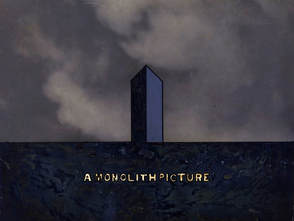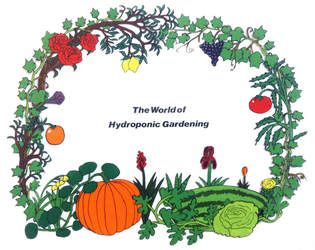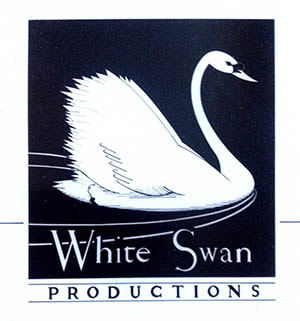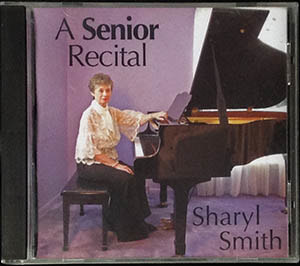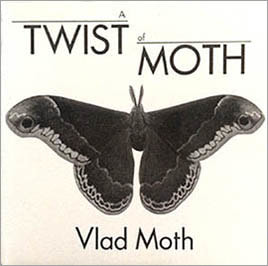Early On...
Sometime late in elementary school I had heard the stories about the starving artist. Being a naive kid, I thought they were totally true. I was unaware at the time of other opportunities, such as working as an illustrator. Although I was good in art, the life of a starving artist wasn't going to be the life for me. So I cast around for alternatives where I could still be creative but with better prospects.
In junior high school it struck me one day that there was something which combined several creative abilities that I had some talent in. I had developed quite a love for the movies and as I thought about them, I realized that they combined art, writing, and a number of performing skills. The movies, of course!
Of course, I had no idea of how to get into this field, not to mention what exactly what I’d do if I somehow managed to get in the door,.But I didn’t let that stop me. I’d simply read every book on the subject that I could find in the school library and hope that the answer might reveal itself. And I think I might have literally done just that – reading everything from books by pretentious critics (I took a strong dislike to the likes of Pauline Kael) to books with titles that started with “The Films of...” I even ran across a tiny number of books that had information on how to actually make movies.
Sometime during this period I got my first job - a (very) part-time job at a movie theater. It may have only been working behind the concession stand and tearing tickets but it was a job in the "Movie Industry"! Of course it didn’t take long to see just how far removed it was from the real action.
Sometime late in elementary school I had heard the stories about the starving artist. Being a naive kid, I thought they were totally true. I was unaware at the time of other opportunities, such as working as an illustrator. Although I was good in art, the life of a starving artist wasn't going to be the life for me. So I cast around for alternatives where I could still be creative but with better prospects.
In junior high school it struck me one day that there was something which combined several creative abilities that I had some talent in. I had developed quite a love for the movies and as I thought about them, I realized that they combined art, writing, and a number of performing skills. The movies, of course!
Of course, I had no idea of how to get into this field, not to mention what exactly what I’d do if I somehow managed to get in the door,.But I didn’t let that stop me. I’d simply read every book on the subject that I could find in the school library and hope that the answer might reveal itself. And I think I might have literally done just that – reading everything from books by pretentious critics (I took a strong dislike to the likes of Pauline Kael) to books with titles that started with “The Films of...” I even ran across a tiny number of books that had information on how to actually make movies.
Sometime during this period I got my first job - a (very) part-time job at a movie theater. It may have only been working behind the concession stand and tearing tickets but it was a job in the "Movie Industry"! Of course it didn’t take long to see just how far removed it was from the real action.
High School
High school opened opportunities. There was a film class where you could actually learn how to shoot and edit your own movies (mostly on super 8 film). There was also had a student film festival, so I really felt like I was finally getting a start.
I shot on standard 8 film, super 8mm and even some 16mm film. It was mostly live action films but I did do some animation as well. In fact, I was really taken by animation and wanted to do more of it. Because of what I had available as well as where my abilities were at the time, I seemed to be limited mostly to doing stop motion clay animation. I was very inspired through this time by the short animated films I saw once a year when the “International Tournee of Animation” played (one week only) in town.
High school opened opportunities. There was a film class where you could actually learn how to shoot and edit your own movies (mostly on super 8 film). There was also had a student film festival, so I really felt like I was finally getting a start.
I shot on standard 8 film, super 8mm and even some 16mm film. It was mostly live action films but I did do some animation as well. In fact, I was really taken by animation and wanted to do more of it. Because of what I had available as well as where my abilities were at the time, I seemed to be limited mostly to doing stop motion clay animation. I was very inspired through this time by the short animated films I saw once a year when the “International Tournee of Animation” played (one week only) in town.
|
Gnizah! (1978) This was one of three movies I made during my high school career for the student film festival and was the best received. The other films, "The Fountain" and "High Pressure" didn't get the same positive reaction. I could usually only get one reel of film to shoot on at any given time so there were no second tries but for an extremely amateur film it was nice to taste at least a little bit of success. |
|
I managed to get a little job at a film lab at one point splicing together reels of super 8 film. I had tried earlier to get connected to a local production company that made religious films. I was excited about it because it was the only place in town that made feature length films. But, of course this life ended with graduation and I wasn’t sure what would happen next. I just hadn't done enough yet to try to find work in this field so I had to look to the possibility of college.
College
The big film schools such as UCLA or the University of California weren't an option and I certainly didn't want to go into debt, so I looked for something closer to home. I had checked out a state university and was impressed that they had an Arriflex 16mm camera for student use. That is, until I found out that access to it was only for one week during your senior year. So I had to find someplace where more hands-on experience was possible. I found out about an affordable college right in my town that had a 16mm camera (a Bolex) that students could actually use, The joke ended up being on me after I started that first year because the Bolex ended up being stolen and was never replaced.. But my resourcefulness eventually won out and I was sometime later able to buy my own 16mm camera, a 1946 model Bolex H-16, a camera so early that the footage counter was an add-on accessory. I still have that camera and love to look at it every once in a while.
The curriculum of the Communications Department (Radio/TV/Film) ended up being somewhat, well, different than what I was striving for. It was more aimed toward those who wanted to be newscasters or radio announcers. The big production that everyone participated in was a live broadcast of the basketball game over cable TV. The emphasis was more on covering things (reporting) than on creating original programming (writing a script and rehearsing). I did class projects, of course, but also made an effort to shoot my own films, even though there really wasn't an outlet for them as there had been with my high school's student film festival. Still I was able to learn and develop some while trying out some new areas (documentaries and other forms).
The big film schools such as UCLA or the University of California weren't an option and I certainly didn't want to go into debt, so I looked for something closer to home. I had checked out a state university and was impressed that they had an Arriflex 16mm camera for student use. That is, until I found out that access to it was only for one week during your senior year. So I had to find someplace where more hands-on experience was possible. I found out about an affordable college right in my town that had a 16mm camera (a Bolex) that students could actually use, The joke ended up being on me after I started that first year because the Bolex ended up being stolen and was never replaced.. But my resourcefulness eventually won out and I was sometime later able to buy my own 16mm camera, a 1946 model Bolex H-16, a camera so early that the footage counter was an add-on accessory. I still have that camera and love to look at it every once in a while.
The curriculum of the Communications Department (Radio/TV/Film) ended up being somewhat, well, different than what I was striving for. It was more aimed toward those who wanted to be newscasters or radio announcers. The big production that everyone participated in was a live broadcast of the basketball game over cable TV. The emphasis was more on covering things (reporting) than on creating original programming (writing a script and rehearsing). I did class projects, of course, but also made an effort to shoot my own films, even though there really wasn't an outlet for them as there had been with my high school's student film festival. Still I was able to learn and develop some while trying out some new areas (documentaries and other forms).
Since most of my live action video and film projects included the use of copyrighted music, I can't include them here but I did keep my hand in animation during these years.
|
|
|
|
This film was an imaginary vaudeville act where the clay performers could do magical transformations with their bodies. I tried to save money by developing the film myself, hence the spots during half of it. Such is the learning process.
|
This was an attempt to do hand drawn cel animation. Since I didn't have access to acetate cels and cel paint, I instead used bond paper and ink. Since I wasn't ready to do character animation I used machinery as the subject and used cycles to cut down on the work. This version was recently scanned from the original cels with original music composed for it by Mark Heggen.
|
I had the idea that I would try to learn cinematography well enough that I might start at a television station shooting news and then (a vague notion) find some way to move over to commercials and then into movies themselves. What had seemed to be a stable world was upset by the introduction portable video recorders. Not that path didn't exist. That threw me but I soon adapted and, besides doing my own short film projects, I did projects on video, working with crash edits on a half-inch VTR for one project and later getting access to a VHS editing system that did three-point straight cuts editing(no dissolves or wipes) when the college bought one of those systems.. I wasn't sure how prepared for the real world I was going to be but, ready or not, I would find out.
The Working World and Beyond
It took a little while but I finally joined up with a small production outfit in Clear Lake, Iowa run by brothers from Chicago. I spent a year and a half there and got a good variety of experience. I shot video. I edited it. I wrote advertising copy. I did some logo design. I even got to try some multi-track audio mixing.
When I returned to my home city I was able to get about a job about one day a month at a television station as a Production Assistant. I operated a TV camera and did duties on the set. Eventually,through information from a friend I managed to get a job as a Media Associate (fancy name for an AV guy) at the same high school where I had graduated. The job ended up lasting 13 years. I fit in whatever I could of my production skills with most of it being dubbing videotapes, although I did get a few after hours gigs through them running stage lighting. I did the best I could at the job and was praised for my work by the teachers and staff.
During this time I tried breaking into the film and television businesses. I wrote some spec scripts for television shows I liked, for instance. At a certain point the movie “Who Framed Roger Rabbit?” was a major hit and it completely changed the animation industry. Animation went from a sleepy, dying industry to something very hot. It looked like the promised land.
I had to find a way in and the only way, after studying all the possibilities, appeared to be to go back to school and learn how to be an animator. I found that wasn't reachable in my present circumstances, although I still tried what I could. I visited an animator and producer up in a little studio in Waterloo, Iowa to ask them every question I could think of about how to become an animator and how to get into the industry. I also tried to self-train myself to do character animation with a little project over the summer. It soon became apparent that I would have to wait for now and would have to look into other creative opportunities.
It took a little while but I finally joined up with a small production outfit in Clear Lake, Iowa run by brothers from Chicago. I spent a year and a half there and got a good variety of experience. I shot video. I edited it. I wrote advertising copy. I did some logo design. I even got to try some multi-track audio mixing.
When I returned to my home city I was able to get about a job about one day a month at a television station as a Production Assistant. I operated a TV camera and did duties on the set. Eventually,through information from a friend I managed to get a job as a Media Associate (fancy name for an AV guy) at the same high school where I had graduated. The job ended up lasting 13 years. I fit in whatever I could of my production skills with most of it being dubbing videotapes, although I did get a few after hours gigs through them running stage lighting. I did the best I could at the job and was praised for my work by the teachers and staff.
During this time I tried breaking into the film and television businesses. I wrote some spec scripts for television shows I liked, for instance. At a certain point the movie “Who Framed Roger Rabbit?” was a major hit and it completely changed the animation industry. Animation went from a sleepy, dying industry to something very hot. It looked like the promised land.
I had to find a way in and the only way, after studying all the possibilities, appeared to be to go back to school and learn how to be an animator. I found that wasn't reachable in my present circumstances, although I still tried what I could. I visited an animator and producer up in a little studio in Waterloo, Iowa to ask them every question I could think of about how to become an animator and how to get into the industry. I also tried to self-train myself to do character animation with a little project over the summer. It soon became apparent that I would have to wait for now and would have to look into other creative opportunities.
|
Cat's Meow Brand Cat Food - Pencil Test
This was my attempt to give myself a crash course in character animation. Once again I was using paper cels, and pencil this time, to create the animation. I worked about 2 and half months to do this. I hadn't any training in the 12 basic principles of animation so it is really stiff but it was a reasonable first effort. The animation industry at that time had its boom and bust before I could get on board. Needless to say I missed out on the big animation boom of the 1990s. But I did gain a continuing long term interest that still might bear fruit. |
|
Production at Last!
After working a second job to pay off some debt, I wanted to do something fun for a change and found out about a public access cable TV show that was being done by someone named Gene Hamilton. I met him in 1995 and we’ve been best friends ever since, through many ups and downs. His show, "The Art Roamer Round-Up TV Show" finally gave me a chance to exercise some of my production skills, although in the most primitive way (crash edits between VCRs and very low end consumer grade title generators and other equipment). Although we never got it to the point where it broke out of public access cable TV, we did gain a following of fans and won Des Moines Cityview's "Best Of" award for "Best Public Access TV Show".
After working a second job to pay off some debt, I wanted to do something fun for a change and found out about a public access cable TV show that was being done by someone named Gene Hamilton. I met him in 1995 and we’ve been best friends ever since, through many ups and downs. His show, "The Art Roamer Round-Up TV Show" finally gave me a chance to exercise some of my production skills, although in the most primitive way (crash edits between VCRs and very low end consumer grade title generators and other equipment). Although we never got it to the point where it broke out of public access cable TV, we did gain a following of fans and won Des Moines Cityview's "Best Of" award for "Best Public Access TV Show".
Eventually digital production came within reach. You could buy an iMac with iMovie, shooting with a digital camcorder and do things that we had only previously only dreamed of being able to do. It was a major step up and the quality was light years better.
|
|
|
|
,We ended up making a pilot for a TV show called “The Little Woody Show” and three short films - “The Visitor”, “The Headed Horseman”, and “The Exercist”.
We even entered these in film festivals. “The Little Woody Show” won an award for “Best TV Pilot” at the Mammoth Film Festival in California and “The Visitor” and “The Headed Horseman” were selections for the Rural Route Film Festival in Brooklyn, New York as well as the Cedar Rapids Independent Film Festival in Cedar Rapids, Iowa. We could only do this for so long before circumstances changed. |
|
It was at that point that I decided it would be best to spend time studying screenwriting to hone my skills, which I did for five years. The quality of my scripts gradually got better and I reached the point where I could start telling a good story. I never did manage to get all the way through writing a feature length screenplay. But that may still happen someday.
Some finished or nearly finished scripts for short films that still may be made:
|
| ||||||||||||
Iowa Film Incentives Opportunities
One thing that was exciting and encouraging for awhile was the Iowa Film Incentives. Suddenly the state was hopping with film production activity and it seemed like working in movies was viable. After not trusting what was happening for a few months and expecting it all to vaporize, I finally decided to try to get in something. The film I finally got a chance to work on was "Splatter: Love, Honor, and Paintball". Although not a summer blockbuster, It seemed like it could have a life on cable television.
My job title was "DocuCam", an invented name to describe shooting documentary footage to be later used in the DVD extras. Unfortunately the movie never ended up getting released. I did get paid though and it was the most I had ever been paid for anything. I was going to try to get on another film but then the whole film incentive fiasco happened. It was like an atomic bomb had gone off, clearing nearly every bit of profession feature film and national television production activity from the state. All that remained were local filmmakers who hadn't risen far enough yet to provide paying projects.
I haven't done any full fledged movies since then but I have done some little projects - an animated movie company logo and some Movie Night opening pieces for myself.
One thing that was exciting and encouraging for awhile was the Iowa Film Incentives. Suddenly the state was hopping with film production activity and it seemed like working in movies was viable. After not trusting what was happening for a few months and expecting it all to vaporize, I finally decided to try to get in something. The film I finally got a chance to work on was "Splatter: Love, Honor, and Paintball". Although not a summer blockbuster, It seemed like it could have a life on cable television.
My job title was "DocuCam", an invented name to describe shooting documentary footage to be later used in the DVD extras. Unfortunately the movie never ended up getting released. I did get paid though and it was the most I had ever been paid for anything. I was going to try to get on another film but then the whole film incentive fiasco happened. It was like an atomic bomb had gone off, clearing nearly every bit of profession feature film and national television production activity from the state. All that remained were local filmmakers who hadn't risen far enough yet to provide paying projects.
I haven't done any full fledged movies since then but I have done some little projects - an animated movie company logo and some Movie Night opening pieces for myself.
Some Little Projects
|
|
|
|
Lucid Dreams Productions logo
I did this for a guy who had used a picture from a record cover to use for his company logo at the start of his films. I suggested to him that, rather than risk a copyright infringement suit, that he let me try to come up with an animated version of the same concept. It took me three months to figure out how to do it but I managed to get something that looked good. I created a background image in Photoshop that was a composite of a whole lot of elements (mountains, cactus, rock formations, etc.) from a lot of source photos and altered more than enough to be considered original. It served as a sort of virtual billboard in Blender for the flying saucer to come down in front of. I didn't know about the "shadeless" option with pictures on planes so it had an overcast appearance which I simply went with. After it had been rendered, I took this file into After Effects where I added the title and an animated shadow to sell the idea that the saucer was descending in a three dimensional environment. |
Movie Night Opening - "Titanic"
For a number of years I've hosted for friends a Movie Night evening where I'll screen either classic or cult movies. One of my friends who comes to it had edited together a feature film of what he considered to be the ultimate Titanic movie out of pieces of several motion pictures that dramatized the famous sinking. (It was surprisingly seamless.) We decided to screen it for a "World Premiere" and because it was one of the rare occasions where we were screening an original production by one of us. I decided to create a little opening for it. I did most of it in Photoshop, which has a workspace in it for motion and animation. I pieced together several elements to put together into a whole (the ship, ocean waves, night sky, iceberg, etc.) and it turned out surprisingly well. It was helped a little bit in After Effects and some music was added to it from free stock music. |
|
|
ZAM Development Group Screen Logo
This is a motion graphic in the form of an animated logo for a filmmaker along the same kind of arrangement that I did for the Lucid Dreams Productions screen logo. I plan to do a few of these for my reel with the idea of using this as a bridge into animation. Hopefully motion graphics won't last too long as an activity and I can move fairly fast into more character driven work. The logo was made in Blender and the background was created and animated in Photoshop, as well as colorizing the logo itself. The job included a redesign of an existing logo. |
|
Keeping Vigil Productions screen logo
This animated logo goes beyond the simpler animation of the other two screen logos I have done. Still relatively simple as animation, it gets closer to character animation, which is my first love. The flame was shot live action. The eyes were animated in Blender, although there are 2D software packages that could have produced the same look. The lettering and fades were put in last using After Effects. I look at these logo projects as a start toward where I'd really like to be. I'm thinking I'll start with straight graphic design just to get out of the typical kind of day job, move into motion graphics, such as these, and finally move into story based character animation. |
|
|
|
ASIFA/Central 2018 Ani-Jam segment
I belong to the international animation organization ASIFA ((Association Internationale du Film d’Animation or, in english, the International Animated Film Association). I'm the sole member in Iowa of the Central chapter which covers the Midwestern United States. I completed this segment recently for a project they do for International Animation Day and it is based on the poster for it. It was completed using both Blender and Photoshop and used images from the poster which were supplied. The challenge was to create a 3 second sequence (72 frames) that would transition from one image on the poster to the next. I added animation to the images for interest. |
Facebook Groups
I did do something positive after the film incentive disaster. I formed a few Facebook groups to connect Iowa film people with each other. The most successful has been "Iowa Film" which has over 1000 members and now pretty much runs itself without a lot of prompting from me. From time to time I’ll post informative articles to help steer things somewhat into a more professional, high quality direction. I’m very proud of where the members have come, going from doing just schlocky zombie flicks to now doing more diverse work and sophisticated work. I don't know how soon it will be but perhaps one day someone will win a prestigious award or make a mark internationally.
Other film-related groups I have are "Iowa Animation" and "Iowa FX People" and I am a co-administrator of the group "Iowa Actors & Crew Together", an even larger group than "Iowa Film".
I did do something positive after the film incentive disaster. I formed a few Facebook groups to connect Iowa film people with each other. The most successful has been "Iowa Film" which has over 1000 members and now pretty much runs itself without a lot of prompting from me. From time to time I’ll post informative articles to help steer things somewhat into a more professional, high quality direction. I’m very proud of where the members have come, going from doing just schlocky zombie flicks to now doing more diverse work and sophisticated work. I don't know how soon it will be but perhaps one day someone will win a prestigious award or make a mark internationally.
Other film-related groups I have are "Iowa Animation" and "Iowa FX People" and I am a co-administrator of the group "Iowa Actors & Crew Together", an even larger group than "Iowa Film".
Recording
Besides the above, I've also done some recording for other people. I’ve produced a private album of classical music for Sheryl Smith and an EP for Brad Roth (aka “Vlad Moth”) . I designed the cover and label art as well.
Besides the above, I've also done some recording for other people. I’ve produced a private album of classical music for Sheryl Smith and an EP for Brad Roth (aka “Vlad Moth”) . I designed the cover and label art as well.
Like the picture in the header for this section, the Media Studio may look a bit decrepit but still shows promise..
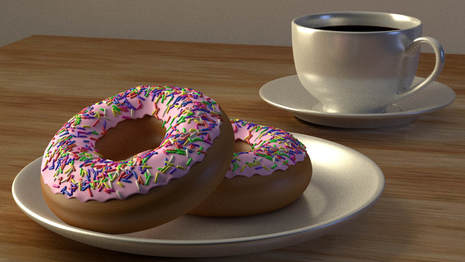
Most Recently
After several versions, the 3D modeling and animation application that I used for that moving logo with the flying saucer, Blender, has developed far enough and has become stable enough in its interface that I've decided it was worth putting in the time again to try to learn it. I feel much more comfortable with it now and feel like I can now think about developing an animation and VFX reel. To the left is the result of a set of tutorials I just completed to learn the basics of this software.
I'm well along with a project called "Paper Cinema". It is a new concept of telling a cinematic story on the printed page. The form preserves as much as possible the characteristics of a movie. Currently there's a Facebook page called "The Paper Cinema Project" that has a lot of posts about various topics that will be included in the book I am writing about it. The first draft of the book has been written and I am well along with the rewrite stage of it, which includes some reorganization of information. There is also the need to create pictorial content.
I've had to put the Paper Cinema project on hold for a little while because I have been given a great opportunity in the form of writing a spec screenplay for someone. Although I can't reveal the details I can say that because of the people involved it stands a much better chance of becoming something than the typical situation where a writer creates one and hopes for the best.
Stay tuned for more...
After several versions, the 3D modeling and animation application that I used for that moving logo with the flying saucer, Blender, has developed far enough and has become stable enough in its interface that I've decided it was worth putting in the time again to try to learn it. I feel much more comfortable with it now and feel like I can now think about developing an animation and VFX reel. To the left is the result of a set of tutorials I just completed to learn the basics of this software.
I'm well along with a project called "Paper Cinema". It is a new concept of telling a cinematic story on the printed page. The form preserves as much as possible the characteristics of a movie. Currently there's a Facebook page called "The Paper Cinema Project" that has a lot of posts about various topics that will be included in the book I am writing about it. The first draft of the book has been written and I am well along with the rewrite stage of it, which includes some reorganization of information. There is also the need to create pictorial content.
I've had to put the Paper Cinema project on hold for a little while because I have been given a great opportunity in the form of writing a spec screenplay for someone. Although I can't reveal the details I can say that because of the people involved it stands a much better chance of becoming something than the typical situation where a writer creates one and hopes for the best.
Stay tuned for more...
Site powered by Weebly. Managed by ZebraHost
Photo used under Creative Commons from Cory Seamer
